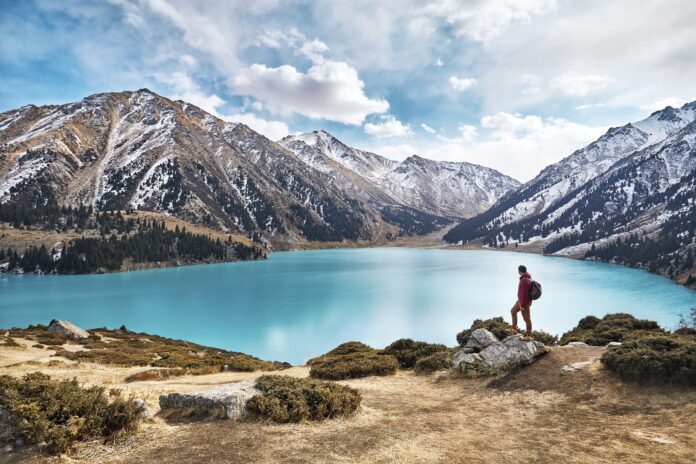Sipping black tea with milk from a blue-and-white ceramic bowl, I felt a surge of nostalgia in the village of Saty, nestled in the heart of southern Kazakhstan. After a day-long drive through a surreal landscape of vast steppe grasslands, narrow gorges, and snow-capped peaks, I found myself reconnecting with the land of my birth. Born in Almaty, the former capital, I had spent childhood summers visiting my grandmother here. But my experiences had been confined to the city limits, until now.
The towering peaks of the Tian Shan mountain range serve as a natural border between southeastern Kazakhstan and its neighbors Kyrgyzstan and China. It’s in this region, the Almaty region, that the country’s most awe-inspiring vistas lie. After years abroad, I returned with a dream – to explore this vast nation beyond the confines of my birth city.
My story is not unique – many travelers have only scratched the surface of Kazakhstan. Despite being 40 times larger than Georgia, its Caspian neighbor, Kazakhstan drew only a fraction of the visitors Georgia did in 2022. Most tourists confined themselves to the two largest cities, Almaty and Astana. Yet, those who ventured beyond the urban centers discovered a rugged land where nomadic traditions thrive, horses and camels roam the steppe, and Kazakh culture comes alive.
Kazakhstan’s history is layered, a tapestry woven by centuries of Turkic tribes and Silk Road caravans crossing the vast steppes. Today, its history is most visible in the Almaty region, but much was lost during the Soviet era. Kazakh youth today are eager to reclaim their heritage and rediscover their roots.
This was my mission as well. Though I had cherished memories of exploring orchards and climbing mountains during my visits, my understanding of Kazakh identity and history had deepened while I was abroad. There was so much more to Kazakhstan than Almaty, and in recent years, many Kazakhs have been embracing their country’s rural landscapes. National parks have been improved, and eco-hotels have sprung up. I embarked on a road trip to witness the remote countryside before it became a well-trodden path.

Surprisingly, I didn’t have to venture far. Despite its immense size, the Almaty region is a microcosm of Kazakhstan’s beauty. As my guide and I set off before dawn, we drove along the Kuljin road, which stretches eastward to the Chinese border, revealing the Tian Shan mountains in the distance. A turn south led us to the Asy Plateau, a 60km expanse of alpine meadows. This landscape, a relic of Turkic transhumance, where shepherds move their herds between high-altitude pastures, captured a timeless essence.
With each kilometer, eras shifted. At the plateau’s western edge stood the Assy-Turgen Observatory, operating since 1981. Its telescope, among the world’s largest, recently observed a cosmic explosion five billion light years away. Nearby, I paused to absorb the majestic scenery – a landscape that had seen centuries pass.
Journeying eastward, I encountered kurgans, ancient burial mounds along the Asy River, remnants of the Saka culture from the Iron Age. These routes were once traveled by Silk Road caravans. I felt an ancestral connection, a missing piece of my heritage falling into place.
The journey continued through Charyn National Park, its canyon often compared to the Grand Canyon. The winding Charyn River had etched a surreal landscape of red, yellow, and white rock, revealing dwellings and tools from bygone eras. In this rugged terrain, history was palpable.
As we turned west, Altyn-Emel National Park beckoned, with its deserts, mountains, and steppes. The park’s biodiversity had earned it Unesco recognition, a haven for rare species seeking refuge. Among its treasures was the “Singing Dunes,” where the wind’s melody resembled the nomadic throat-singing tradition.
Reflecting on the journey, I realized that Kazakh culture is intrinsically tied to the land. Nomadic roots run deep, and the beauty of the country’s diverse landscapes embodies its essence. As I returned to urban life, I carried with me a profound understanding of Kazakhstan’s heritage – a heritage inseparable from the land itself.





